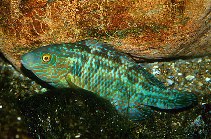http://www.fishbase.org/Summary/speciesSummary.php?genusname=Symphodus&speciesname=melops ---> http://192.134.151.83/Summary/speciesSummary.php?genusname=Symphodus&speciesname=melops
http://192.134.151.83/Summary/speciesSummary.php?genusname=Symphodus&speciesname=melops ---> https://fishbase.mnhn.fr/Summary/speciesSummary.php?genusname=Symphodus&speciesname=melops
https://fishbase.mnhn.fr/Summary/speciesSummary.php?genusname=Symphodus&speciesname=melops ---> https://fishbase.mnhn.fr/summary/Symphodus-melops.html
Symphodus melops, Corkwing wrasse : fisheries, gamefish, aquarium

You can
sponsor
this page
Common name (e.g. trout)
Genus + Species (e.g. Gadus morhua)
-

-
About this page
-
Languages
-
User feedbacks
-
Citation
-
Uploads
-
Related species
-


 Corkwing wrasse
Add your observation in
Fish Watcher
Upload your
photos
and
videos
Corkwing wrasse
Add your observation in
Fish Watcher
Upload your
photos
and
videos
Pictures
|
Google image
 Symphodus melops
Symphodus melops
Picture by
JJPhoto
Teleostei (teleosts) >
Eupercaria/misc
(Various families in series Eupercaria) >
Labridae
(Wrasses)
Etymology:
Symphodus:
Greek, syn, symphysis = grown together + Greek, odous = teeth (Ref.
45335
)
.
More on author:
Linnaeus
.
Environment: milieu / climate zone / depth range / distribution range
Ecology
Marine; reef-associated; non-migratory, usually 1 - 30 m (Ref.
35388
). Temperate; 63°N - 28°N, 32°W - 25°E
Eastern Atlantic: Norway to Morocco and the Azores. Also known from the western Mediterranean and Adriatic seas.
Length at first maturity / Size / Weight / Age
Maturity: L
m
8.5
, range 7 - 10 cm
Max length : 28.0 cm SL male/unsexed; (Ref.
4742
); common length : 20.0 cm SL male/unsexed; (Ref.
4742
); max. reported age: 9 years (Ref.
4742
)
Dorsal
spines
(total): 14 - 17;
Dorsal
soft rays
(total): 8-10;
Anal
spines
: 3;
Anal
soft rays
: 8 - 11. A few cephalic pores (7-12) on snout. Lips with 5-7 folds. Scales on temporo-occipital surface 3-5 rows; on inter-operculum 2-3 (6-13) scales; on cheek 4-7; behind eye 1. A small dark spot on caudal peduncle. Often 5 large brown blotches near dorsal fin. Females and young: with numerous spots on body more or less longitudinally lined, some sinuous lines on head (Ref.
231
). Coloration very variable; ground color of the male is greenish or blue while females are brownish to yellowish (Ref.
35388
).
This schooling, territorial fish occurs in the littoral zone, near rocks and eel-grass beds, also in lagoons. In summer ripe females show short ovipositor. Seaweed nest built by male among rocks or in crevices. Sex reversal sometimes observed. Feed on mollusks, hydroids, bryozoans, worms and various crustaceans (Ref.
4742
). Males grow faster than females (Ref.
4742
). Oviparous, distinct pairing during breeding (Ref.
205
).
Sex reversal sometimes observed. Seaweed nest built by male among rocks or in crevices (Ref.
4742
). Oviparous, distinct pairing during breeding (Ref.
205
).
Quignard, J.-P. and A. Pras
, 1986. Labridae. p. 919-942. In P.J.P. Whitehead, M.-L. Bauchot, J.-C. Hureau, J. Nielsen and E. Tortonese (eds.) Fishes of the north-eastern Atlantic and the Mediterranean. UNESCO, Paris. Vol. 2. (Ref.
4742
)
IUCN Red List Status (Ref.
130435
)
Least Concern (LC)
; Date assessed:
15 October 2008
CITES
Not Evaluated
Not Evaluated
Threat to humans
Harmless
Human uses
Fisheries: subsistence fisheries; gamefish: yes; aquarium: public aquariums
FAO - Publication:
search
|
FishSource
|
Sea Around Us
More information
Countries
FAO areas
Ecosystems
Occurrences
Introductions
Stocks
Ecology
Diet
Food items
Food consumption
Ration
Common names
Synonyms
Metabolism
Predators
Ecotoxicology
Reproduction
Maturity
Spawning
Spawning aggregation
Fecundity
Eggs
Egg development
Age/Size
Growth
Length-weight
Length-length
Length-frequencies
Morphometrics
Morphology
Larvae
Larval dynamics
Recruitment
Abundance
BRUVS
References
Aquaculture
Aquaculture profile
Strains
Genetics
Electrophoreses
Heritability
Diseases
Processing
Nutrients
Mass conversion
Collaborators
Pictures
Stamps, Coins Misc.
Sounds
Ciguatera
Speed
Swim. type
Gill area
Otoliths
Brains
Vision
Tools
Bio-Quiz
|
E-book
|
Field guide
|
Identification keys
|
Length-frequency wizard
|
Life-history tool
|
Point map
|
Classification Tree
|
Catch-MSY
|
Special reports
Check for Aquarium maintenance
|
Check for Species Fact Sheets
|
Check for Aquaculture Fact Sheets
Download XML
Summary page
|
Point data
|
Common names
|
Photos
Internet sources
AFORO (otoliths)
|
Aquatic Commons
|
BHL
|
Cloffa
|
BOLDSystems
|
Websites from users
|
Check FishWatcher
|
CISTI
|
Catalog of Fishes
:
genus
,
species
|
DiscoverLife
|
DORIS
|
ECOTOX
| FAO - Publication:
search
|
Faunafri
| Fishipedia |
Fishtrace
| GenBank:
genome
,
nucleotide
|
GloBI
|
Google Books
|
Google Scholar
|
Google
| IGFA World Record |
MitoFish
|
National databases
|
Otolith Atlas of Taiwan Fishes
|
Public aquariums
|
PubMed
|
Reef Life Survey
| Socotra Atlas |
Tree of Life
| Wikipedia:
Go
,
Search
| World Records Freshwater Fishing |
Zoological Record
Estimates based on models
Preferred temperature (Ref.
123201
): 8.8 - 17.2, mean 10.5 °C (based on 514 cells).
Phylogenetic diversity index (Ref.
82804
): PD
50
= 0.5005 [Uniqueness, from 0.5 = low to 2.0 = high].
Bayesian length-weight: a=0.00871 (0.00572 - 0.01326), b=3.10 (2.98 - 3.22), in cm total length, based on LWR estimates for this species & Genus-body shape (Ref.
93245
).
Trophic level (Ref.
69278
): 3.4 ±0.1 se; based on diet studies.
Resilience (Ref.
120179
): Medium, minimum population doubling time 1.4 - 4.4 years (K=0.21-0.41; tm=2-3; tmax=9).
Fishing Vulnerability (Ref.
59153
): Low to moderate vulnerability (34 of 100).
Climate Vulnerability (Ref.
125649
): Moderate vulnerability (44 of 100).
Price category (Ref.
80766
):
Very high
.
Nutrients (Ref.
124155
): Calcium = 19.5 [8.0, 34.5] mg/100g; Iron = 0.208 [0.114, 0.446] mg/100g; Protein = 18.8 [15.8, 21.0] %; Omega3 = 0.366 [0.197, 0.695] g/100g; Selenium = 6.08 [2.79, 13.51] μg/100g; VitaminA = 78.2 [19.8, 379.4] μg/100g; Zinc = 0.715 [0.465, 1.300] mg/100g (wet weight);
Back to Search
Random Species
Back to Top
Accessed through:
Not available
FishBase mirror site :
localhost
Page last modified by :
mrius-barile
- 20 July 2016
Fatal error
: Uncaught ArgumentCountError: Too few arguments to function checkEcotox(), 1 passed in /var/www/html/summary/speciessummary.php on line 2304 and exactly 3 expected in /var/www/html/includes/speciessummary.lib.php:2579 Stack trace: #0 /var/www/html/summary/speciessummary.php(2304): checkEcotox() #1 {main} thrown in
/var/www/html/includes/speciessummary.lib.php
on line
2579
|